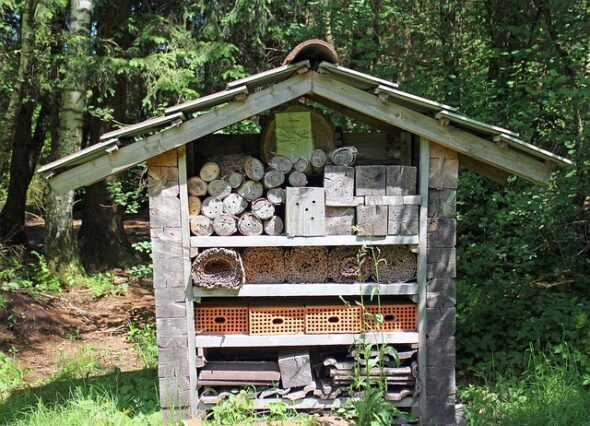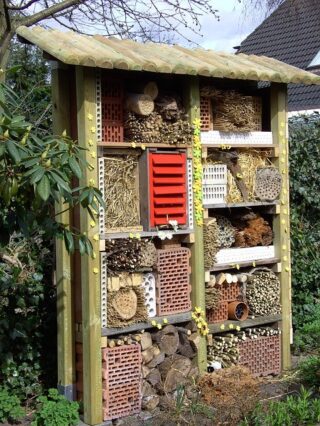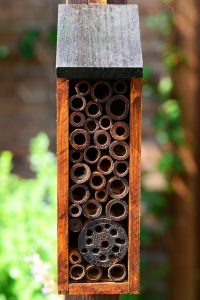Bug hotels, insect houses or creepy crawly mansions. Whatever you call them, there are loads of benefits of having one in your garden.
Not only do they look like an interesting piece of garden décor, they work like magic at encouraging all sorts of insects to set up residence. A diverse range of insects in the garden helps to keep unwanted pests at bay, and that’s very important when you’re growing your own fruit and veg. Read more about natural pest control here.

A bug hotel will encourage the types of insects that are natural predators of the one’s that eat your plants. A bug hotel in your garden will encourage birds to visit, and they will help to rid your garden of slugs! It’s natural pest control with minimal effort.
It’s not just good for the garden! Bug hotels provide a habitat for some of our native insects, such as bumblebees, that are declining in numbers in the wild.
Habitats for Insects
Habitats play a crucial role in providing a conducive environment for insects to thrive and fulfill their essential role in ecosystems. Each habitat offers its unique characteristics that cater to the specific needs of insects. By understanding and preserving these habitats, we can ensure the conservation of insect species and the vital ecological services they provide.

Dead wood/bark – a haven for woodlice, centipedes and beetles, it is a great material for filling a bug hotel.
Holes and crevices – these are good habitats for solitary bees, such as mason bees, leaf cutter bees and mining bees. They need tube structures to lay their eggs in. They plug the hole at the end to protect them as they develop. Different sizes of holes are important and each species of insect has its preference. A good way of providing this is to drill different sized holes into the end of a log.
Hollow garden canes – these also make good nesting places. Garden canes can be cut to suit the size of your framework.
Rolled cardboard – this is attractive to lacewings and other insects.
Dry leaves/sticks/pine cones – ladybirds like to hibernate amongst dry, leafy matter.
Straw/hay/dry grass – great for hibernating and keeping the cold out in winter. Make bunches and secure with elastic band, before trimming to fit your bug hotel.
How to Build a Bug Hotel
First you need to decide on the size and shape you want your bug hotel to be. Wooden pallets make the ideal base for a large bug hotel, although any wood can be used. If you do use a pallet, make sure it hasn’t been pre-treated with insecticide! Most pallets are simply heat treated, and you can find this out by seeing the code stamped on the wood (HT).
When you look around, you will be surprised at how many things can be recycled into a bug hotel. An old box, a bird nesting box that’s seen better days, or even an old set of wooden drawers.

Whether you are making a large or small bug hotel, the same rules apply.
Smaller bug hotels can be made from any scrap wood you have, or any wooden containers you find. Make a framework out of wood for the structure, leaving plenty of gaps that can be filled with all the things that insects like.
It’s a good idea to begin at one corner. Put larger items in first so you can secure them well in place using the smaller material. Keep going until you have a full framework.
Bug hotels are great outdoor projects for kids, and as well as being a fun activity, it helps give them an appreciation for the natural world.
Where Should you Put a Bug Hotel?
When setting up a bug hotel, it’s important to choose the right location. Here are some guidelines to keep in mind:
- Sunlight: Select a spot that receives partial sunlight to maximise insect activity. Most beneficial insects prefer areas with a mix of sun and shade.
- Shelter: Place the bug hotel near vegetation or garden areas to provide easy access to food sources for the insects. This could be near flower beds, shrubs, or herb gardens.
- Protection: Ensure that the bug hotel is sheltered from strong winds and extreme weather conditions. A protected location will provide a safe haven for insects to nest and rest.
- Ground Interaction: Position the bug hotel on the ground or slightly elevated to allow ground-dwelling insects to access the shelter easily.
- Water Availability: Consider locating the bug hotel close to a water source, such as a shallow dish of water or a small pond. This will provide insects with a convenient water supply.
Remember to regularly observe the bug hotel and monitor insect activity. Adjust the location if needed to optimise its effectiveness in supporting the local insect population.
Now, all you need to do is wait for your insect guests to arrive!
Bug hotels helps create a safe habitat for insects, and spotting the different varieties that use your bug hotel is an enjoyable way to explore the natural world.
How has encouraging insects benefited your garden? Share in the comments below.
